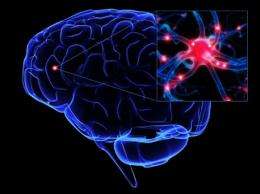Researchers Develop Wireless Method of Brain Stimulation

(PhysOrg.com) -- A new, wireless method of brain stimulation has the potential to activate specific regions of the brain or restore function to damaged or cut nerves, according to a study by Case Western Reserve University researchers.
Ben Strowbridge, an associate professor in the neurosciences department at Case Western Reserve’s School of Medicine, and Clemens Burda, an associate professor in chemistry, collaborated on the project. They say that by using semiconductor nanoparticles as very tiny solar cells they can excite neurons in single cells or groups of cells with visible, or infrared, light.
In their study, the researchers embedded light-activated nanoparticles, which require neither wires nor electrical power, directly into non-human brain tissue and were able to activate neurons. A next step would be to use the technology to activate dispersed groups of neurons at the same time. This would represent a new way of re-creating the complex activity patterns that normally occur in the brain.
In contrast, the researchers say, traditional electrical stimulation of the brain requires arrays of metal electrodes to be implanted. The closer the traditional metal electrode technique gets to re-creating “real” biological activity patterns, the more invasive it becomes. Burda adds that brain stimulation with conventional electrodes can have potentially damaging side effects, ranging from simple physical destruction of cells to chemical reactions from exposure to the electrode materials.
“There are many different reasons you’d want to stimulate neurons—such as repairing injury or restoring function to severed or damaged nerves—and right now you have to put a wire in there, and then connect that to some control system. It is both very invasive and a difficult thing to do,” Strowbridge says.
The researchers expect to be able to implant nanoparticles next to nerves, eliminating the need for wired connections. They can then use light to activate the particles.
The study used brain slices to show that light can trigger neural activity. Their next step is assessing whether the technology can be used to stimulate longer pathways within the intact brain. Clinical development of the technology could lead numerous biomedical applications.
“The long-term goal of this work is to develop a light-activated brain interface that restores function following nerve or brain impairments,” Strowbridge says. “Our findings may open up a whole new world of research possibilities.”
The study is the first report of brain stimulation using light-activated semiconductor nanoparticles. It was published in the journal Angewandte Chemie.
Provided by Case Western Reserve University (news : web)















